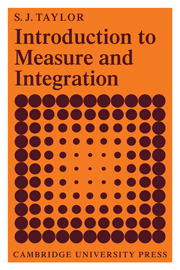Book contents
- Frontmatter
- Contents
- Preface
- 1 Theory of sets
- 2 Point set topology
- 3 Set functions
- 4 Construction and properties of measures
- 5 Definitions and properties of the integral
- 6 Related spaces and measures
- 7 The space of measurable functions
- 8 Linear functionals
- 9 Structure of measures in special spaces
- Index of notation
- General Index
- Frontmatter
- Contents
- Preface
- 1 Theory of sets
- 2 Point set topology
- 3 Set functions
- 4 Construction and properties of measures
- 5 Definitions and properties of the integral
- 6 Related spaces and measures
- 7 The space of measurable functions
- 8 Linear functionals
- 9 Structure of measures in special spaces
- Index of notation
- General Index
Summary
Sets
We do not want to become involved in the logical foundations of mathematics. In order to avoid these we will adopt a rather naive attitude to set theory. This will not lead us into difficulties because in any given situation we will be considering sets which are all contained in (are subsets of) a fixed set or space or suitable collections of such sets. The logical difficulties which can arise in set theory only appear when one considers sets which are ‘too big’—like the set of all sets, for instance. We assume the basic algebraic properties of the positive integers, the real numbers, and Euclidean spaces and make no attempt to obtain these from more primitive set theoretic notions. However, we will give an outline development (in Chapter 2) of the topological properties of these sets.
In a space X a set E is well defined if there is a rule which determines, for each element (or point) x in X, whether or not it is in E. We write x ∈ E (read ‘x belongs to E’) whenever x is an element of E, and the negation of this statement is written x ∉ E. Given two sets E, F we say that E is contained in F, or E is a subset of F, or F contains E and write E ⊂ F if every element x in E also belongs to F. If E ⊂ F and there is at least one element in F but not in E, we say that E is a proper subset of F.
Information
- Type
- Chapter
- Information
- Introduction to Measure and Integration , pp. 1 - 22Publisher: Cambridge University PressPrint publication year: 1973
Accessibility standard: Unknown
Why this information is here
This section outlines the accessibility features of this content - including support for screen readers, full keyboard navigation and high-contrast display options. This may not be relevant for you.Accessibility Information
- 2
- Cited by
